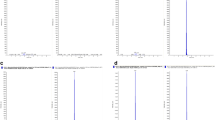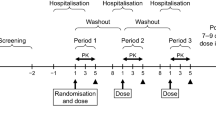Abstract
The bioavailability of four preparations containing dihydrotachysterol (DHT2) was tested in two separate trials with administration of single, oral doses of 1 mg per individual. The relative bioavailability of corresponding preparations (capsules vs capsules and oral solution vs oral solution) was tested in a randomised, crossover pattern within the same group of volunteers. Two different groups of 24 healthy volunteers took part in each trial. Solution and capsule bioavailability was also compared inter-individually. A new sensitive HPLC-method (quantification limit 0.5 ng · ml-1) was used for the measurement of DHT2 concentration in serum.
Three of the preparations tested had a similar bioavailability (mean AUC values of 195.5–223 ng · h · ml-1); the bioavailability of the fourth preparation (A.T.10 oral solution) was considerably lower (mean AUC value 111.5 ng · h · ml-1). The present dosage recommendations of all four preparations are identical.
A new dosage recommendation is thus required for the oral solution with low bioavailability (A.T.10).
Similar content being viewed by others
References
CPMP Working Party on the Efficacy of Medicinal Products 1991. Note for guidance: investigation of bioavailability and bioequivalence. In: Feiden K (ed) (1992) Arzneimittelprüfrichtlinien, 2.Aufl. Wissenschaftliche Verlagsgesellschaft, Stuttgart
Harrison HE, Lifshitz F, Blizzard RM (1967) Comparison between crystalline dihydrotachysterol and calciferol in patients requiring pharmacologic vitamin D therapy. N Engl J Med 276: 894–899
Harrison HE, Harrison HC (1972) Dihydrotachysterol: a calcium-active steroid not dependent upon kidney metabolism. J Clin Invest 51: 1919–1924
Hauschke D, Steinijans VW, Diletti E (1990) A distribution-free procedure for the statistical analysis of bioequivalence studies. Int J Clin Pharmacol Ther Toxicol 28: 72–78
Holtz F, Schreiber E (1930) Einige weitere physiologische Erfahrungen über das bestrahlte Ergosterin und seine Umwand-lungsprodukte. Z Physiol Chem 191: 1–22
Jongen MJM, Vijgh WJF van der, Lips P, Netelenbos JC (1984) Measurement of vitamin D metabolites in anephric subjects. Nephron 36: 230–234
Proteous C, Trafford DJH, Makin HLJ, Cunningham J, Jones G (1988) Use of mass spectrometry in the identification of in vivo and in vitro metabolites of dihydrotachysterol3 in the rat. Biomed Environ Mass Spectrom 16: 87–92
Remagen W, Guncaga J, Lauffenburger TH (1975) Comparison of the effects of vitamin D3, dihydrotachysterol and parathormone on calcium kinetics in the rat. Res Exp Med (Berl) 165: 285–290
Stanbury SW, Mawer EB (1978) Physiological aspects of vitamin D metabolism. In: Lawson DEM (ed) Vitamin D. Academic Press, London, pp 303–341
Taylor A, Bikle DD, Norman ME (1988) Serum dihydrotachysterol levels and biological action in normal man. J Clin Endocrinol Metab67: 198–202
Terepka AR, Chen PS Jr (1962) Comparison of the effects of crystalline dihydrotachysterol, vitamin D2 and parathyroid extract on calcium and phosphorus metabolism in man. J Clin Endocrinol Metab 22: 1007–1011
Author information
Authors and Affiliations
Rights and permissions
About this article
Cite this article
Koytchev, R., Alken, R.G., Vagaday, M. et al. Differences in the bioavailability of dihydrotachysterol preparations. Eur J Clin Pharmacol 47, 81–84 (1994). https://doi.org/10.1007/BF00193484
Received:
Accepted:
Issue Date:
DOI: https://doi.org/10.1007/BF00193484




